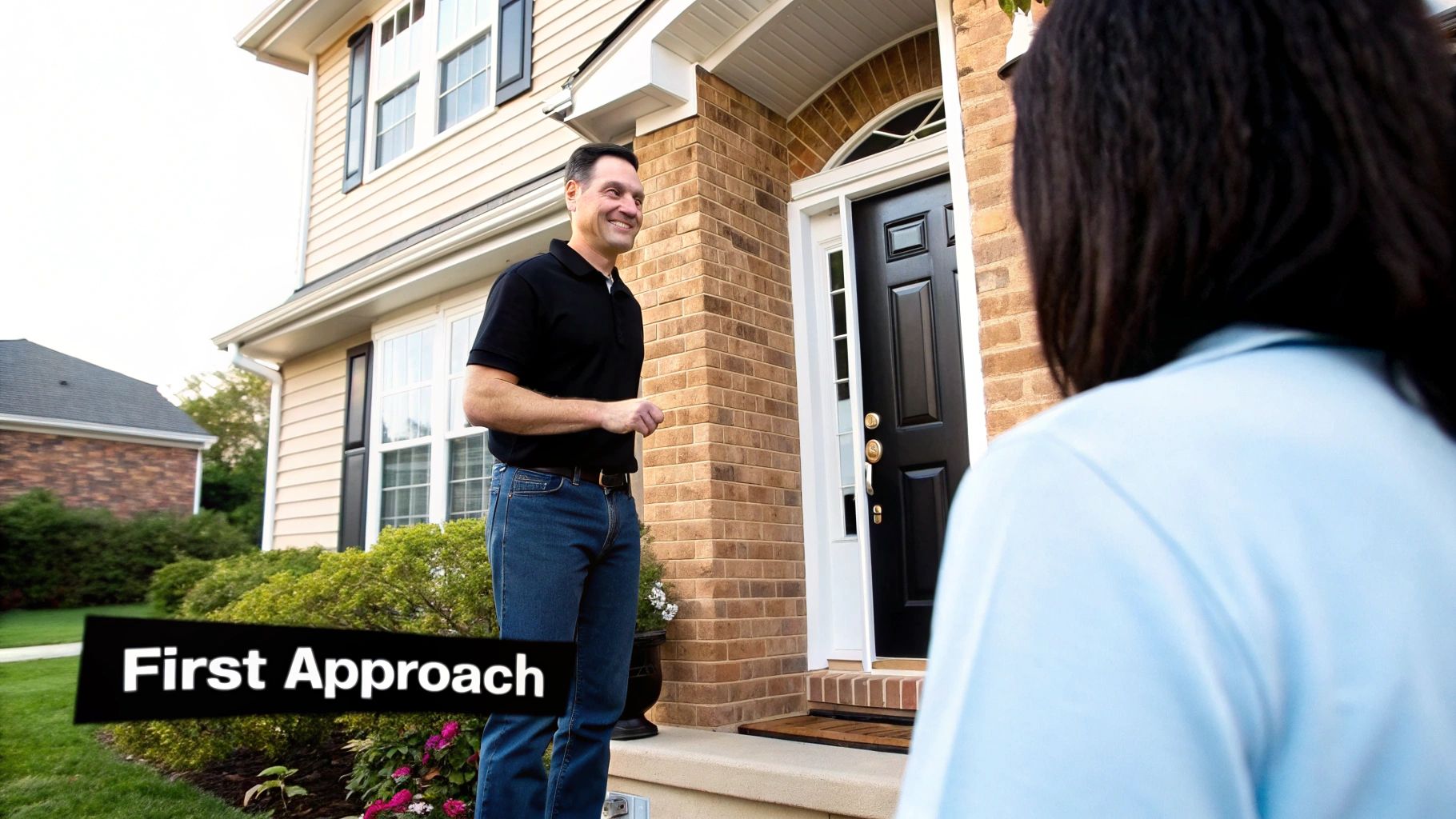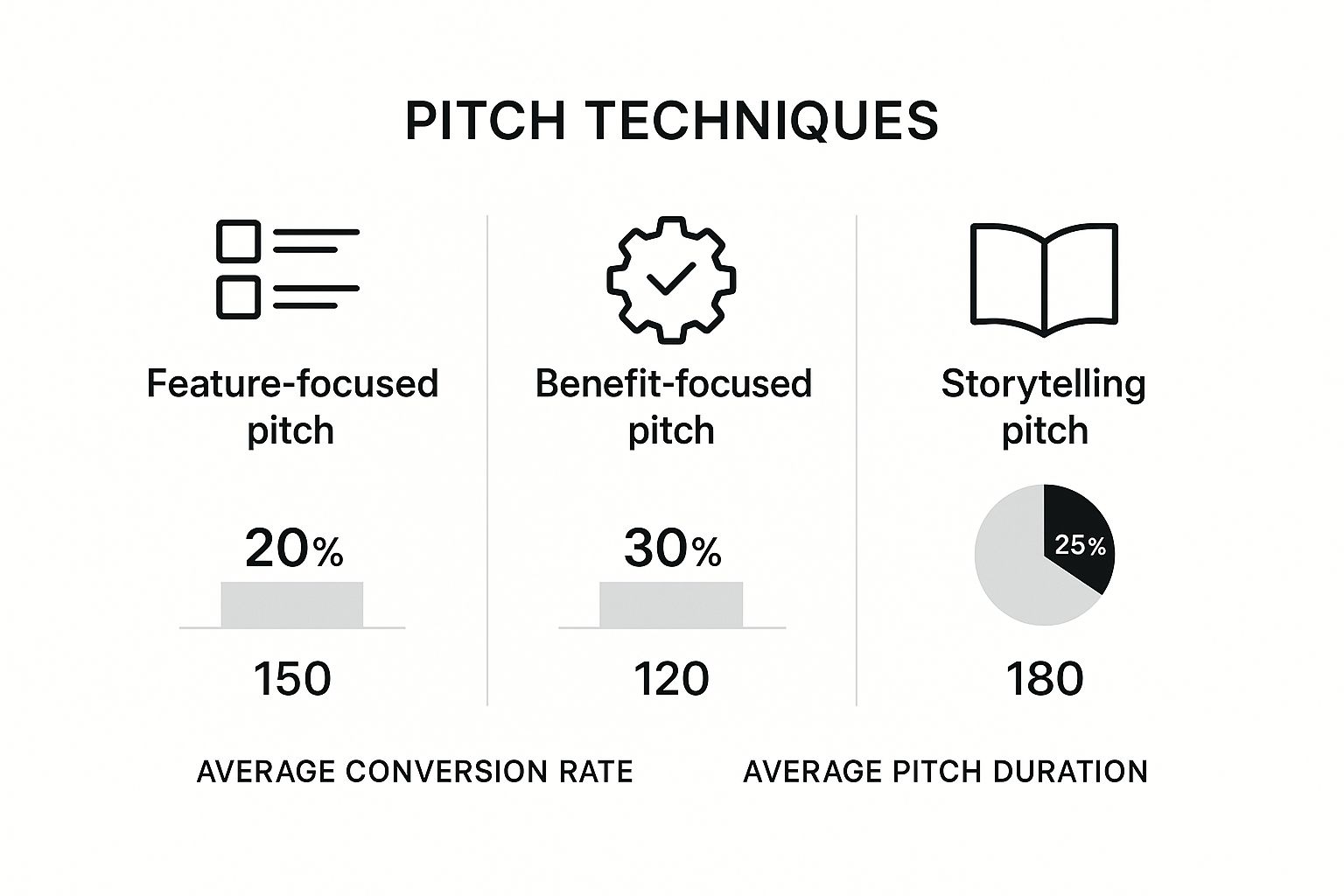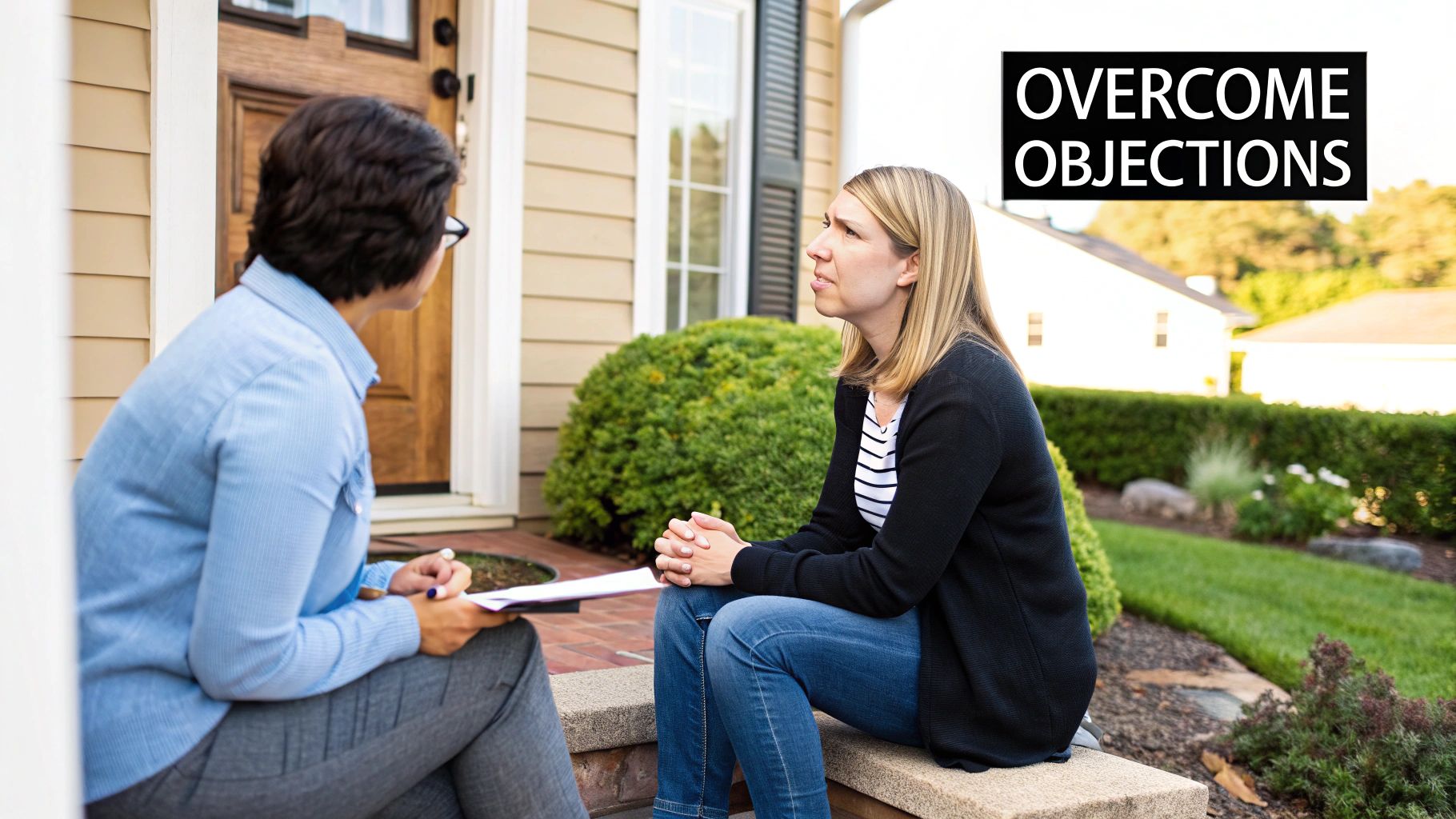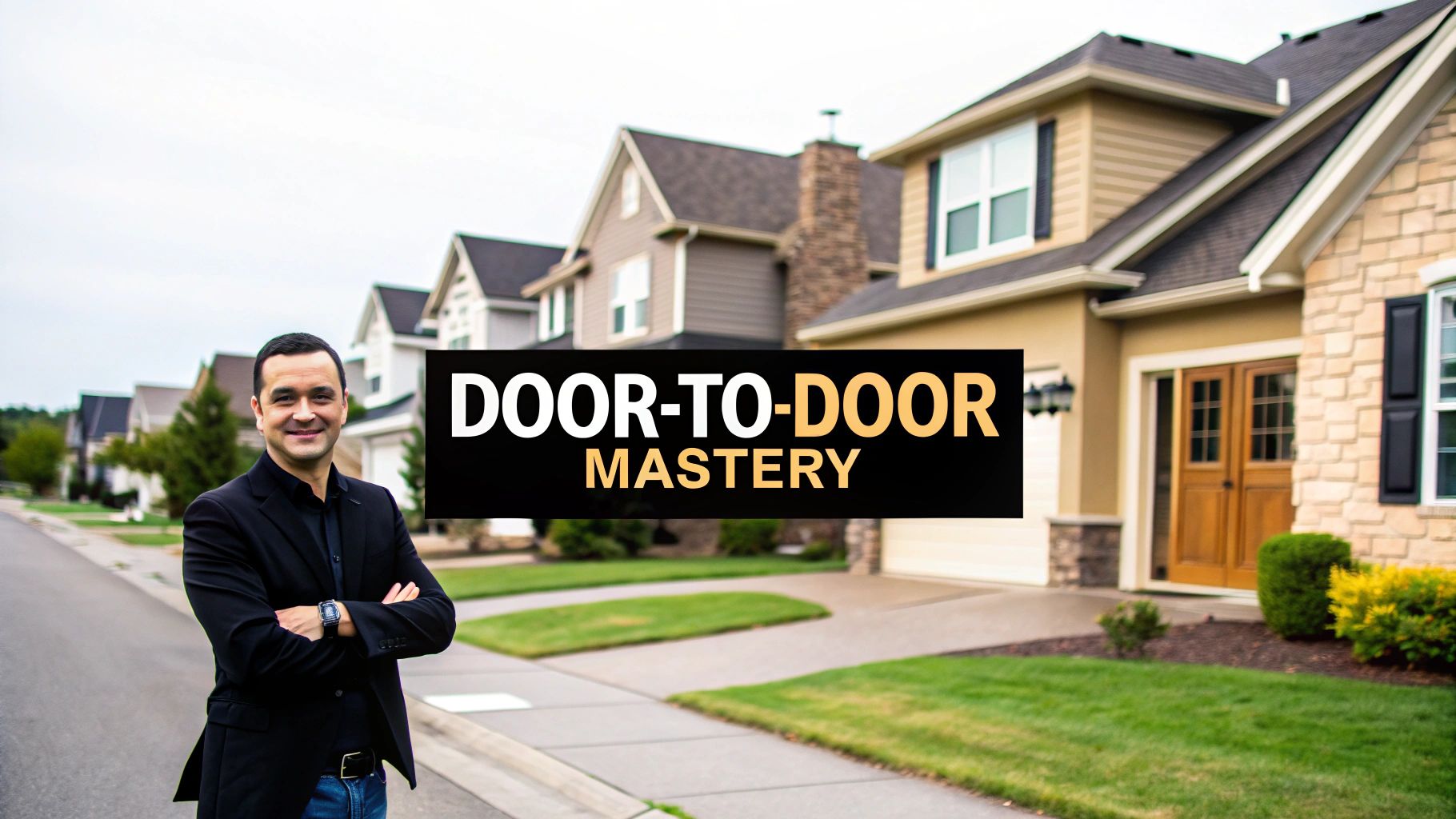Understanding The Door To Door Sales Landscape
Think of door-to-door sales (D2D) as the original social network. Long before we connected online, building relationships meant literally showing up at someone's doorstep. It was – and still is – a real-time test of interpersonal skills, quick thinking, and the ability to build trust quickly.
Forget slick scripts and high-pressure tactics. D2D sales is about genuine human interaction. It’s about reading a situation, understanding those unspoken cues, and responding authentically.
This approach has shaped countless business leaders. Think of Warren Buffett selling chewing gum as a kid or Mary Kay Ash building her cosmetics empire. The lessons learned on the doorstep – persistence, building relationships, and the power of direct communication – are invaluable and translate to any business.
Imagine trying to sell a new home security system. You could send flyers or run online ads. But nothing beats a face-to-face conversation. You can demonstrate the product, answer questions directly, and address concerns immediately. That personal touch can turn skepticism into real interest.
D2D also provides instant feedback. Salespeople quickly learn what works and what doesn’t. This immediate feedback loop helps them refine their approach, adapt their message, and become more effective. That's why, even in our digital world, face-to-face selling remains powerful. It’s about building real relationships, not just collecting clicks. Want to learn more about optimizing D2D sales with a CRM? Check out our guide on door-to-door sales.
Speaking of history, the evolution of door-to-door sales in the U.S. is fascinating. The Fuller Brush Company, founded in 1906, became a national icon, influencing sales practices across the country. Their lifetime guarantee and charismatic sales representatives set a new standard. Want to delve deeper into the past? Discover more insights. Their legacy continues to inspire D2D professionals today.
The Psychology of the Open Door
Why do people open their doors to salespeople? It’s a complex question. Part of it is curiosity; people want to know what you’re offering. Another factor is the human desire for connection. Even a brief interaction can brighten someone's day.
This image from Wikipedia shows a historical image of a door-to-door salesperson, highlighting the personal nature of this approach. It showcases how salespeople engaged directly with potential customers in their homes, emphasizing the history and evolution of D2D sales.
Turning that initial opening into a conversation, and then a sale, requires more than a friendly face. It requires understanding the psychology at play. Top performers get this. They know how to quickly establish rapport, address unspoken concerns, and present their product or service as a solution to a real need. This understanding separates those who struggle from those who consistently exceed their targets. It's about turning an open door into an open mind.
Why California Is A Door-To-Door Sales Goldmine
Forget striking gold—California is where you strike sales. The Golden State isn't just a large market; it's a door-to-door sales powerhouse, a fertile testing ground for ambitious sales professionals. But what makes it so special? Let's explore the key ingredients that make California a recipe for door-to-door sales success.
The California Advantage: Sun, Demographics, and Density
First, let's talk weather. While other parts of the country are shoveling snow, California salespeople are often enjoying beautiful sunshine. This means a longer selling season, more days out in the field knocking on doors, and ultimately, more opportunities to connect with potential customers. Think of it like farming: a longer growing season yields a bigger harvest.
Then there's California’s unique demographic tapestry. From the vibrant energy of Los Angeles to the quiet charm of smaller towns, the state is a melting pot of cultures and backgrounds. This provides invaluable experience for salespeople, forcing them to adapt their approach and master the art of connecting with diverse audiences. It's like a real-world sales boot camp.
And let’s not forget population density. Especially in urban centers, a higher concentration of people in a smaller area means more doors within easy reach. More doors equal more conversations, and more conversations can lead to more closed deals. It's all about maximizing efficiency. Smart teams use data and local insights to target specific neighborhoods, making the most of this density advantage.
California also boasts a diverse economy, spanning everything from Silicon Valley tech giants to thriving agricultural regions. This creates a rich marketplace for a wide range of products and services, allowing sales professionals to specialize and find their niche. Whether you're selling software or solar panels, there's a market for you in California.
Let's take a look at some hard numbers. As of May 2023, California reported 1,120 door-to-door sales jobs, representing 0.06 jobs per thousand workers. The location quotient, a measure of how concentrated a particular occupation is in an area compared to the national average, stands at 1.52. This tells us that door-to-door sales jobs are more prevalent in California than in the rest of the country. The average hourly wage is 19.39**, resulting in an annual mean wage of **40,330. Discover more insights from the Bureau of Labor Statistics.
Seasonal Strategies and Economic Hotspots
Savvy sales professionals in California don’t just work hard; they work smart, leveraging seasonal trends to their advantage. Imagine selling home security systems during the summer months when people are more likely to be on vacation, or promoting energy-efficient products during periods of high utility costs. It's about being in the right place at the right time with the right product.
Finally, California’s economic hotspots play a vital role. Areas with high average incomes and strong purchasing power naturally attract ambitious sales professionals. Think of it like a gold rush, but for sales. This influx of talent creates a competitive environment that pushes everyone to perform at their best, ultimately elevating the overall standard of salesmanship in the state.
Mastering California's Legal Requirements
Door-to-door sales in California present a real opportunity. But understanding the rules of the game is key to long-term success. It's a bit like getting your driver's license – you need to know the rules of the road before you start driving. This section breaks down those "rules of the road" for door-to-door sales, turning potential legal issues into a foundation for a thriving, reputable business.
Registration and Permits: Your Foundation for Legitimacy
First up: registration. Many California cities and counties require door-to-door sales businesses to register and get permits before they start operating. This isn't just a box to check; it shows you're a legitimate business and builds trust with potential customers. Imagine walking up to a homeowner who's not sure if you're the real deal. Showing a valid permit instantly puts their mind at ease and opens the door – literally and figuratively – for a productive conversation.
Understanding "Cooling-Off" Laws: Empowering Consumers, Protecting Your Reputation
California has strong consumer protection laws, including "cooling-off" periods. These laws give customers a set time, usually three days, to cancel a purchase made at their home. This might seem like a hurdle, but it's actually a great way to build trust. By clearly explaining these rights to customers, you're being upfront and building confidence in their decision. This sets you apart from less honest operators and shows you're someone they can trust.
Navigating Solicitation Hours: Respecting Boundaries, Maximizing Efficiency
Local rules often set specific hours for door-to-door sales. These solicitation hours are there to respect people's privacy and avoid being disruptive. It's like making a phone call – there are good times and bad times to reach out. Following these rules not only helps you avoid fines, but it also shows respect for the community, leading to more positive interactions and a warmer reception. Regulations are key in managing door-to-door sales, especially when it comes to employing minors. Anyone employing minors under sixteen for door-to-door sales more than ten miles from their home needs to register with the authorities. Learn more about California's door-to-door sales regulations.

This screenshot from the California Department of Industrial Relations website gives you a look at the specific rules around door-to-door sales. It highlights how important it is to understand and follow these rules. The detailed information on this page shows why careful preparation and sticking to legal requirements are so important for successful and compliant door-to-door operations in California.
Leveraging Technology for Compliance: Streamlining Processes, Enhancing Transparency
Modern tools like LeadFlow Manager can make staying compliant much simpler. Features like automated record-keeping, territory management, and appointment scheduling help ensure you're operating within the law. It's like having a digital assistant keeping you organized and on the right track. By streamlining these tasks, you can focus on what you do best: connecting with people and closing deals. This lets you present yourself professionally and build trust with potential clients. By following the rules and using technology to your advantage, you can turn legal requirements from roadblocks into opportunities, building your reputation and setting yourself up for lasting success in California's dynamic door-to-door sales market.
Proven Strategies That Actually Work
Forget the hard sell. Modern door-to-door sales is all about building relationships and trust. The best in the business act more like helpful advisors than pushy salespeople. They understand that people buy from people they trust, and that trust grows from feeling understood, not pressured. This section explores the techniques that separate the sales superstars from the rest, starting with those critical first 30 seconds at the door.
Making a Strong First Impression
The first few moments of a door-to-door interaction are everything. Think of it like a movie trailer—it has to grab attention and make the prospect want to learn more. A genuine smile, confident posture, and a quick, friendly introduction can work wonders. Instead of diving right into your sales pitch, focus on building a connection. Ask a simple question about their day or offer a sincere compliment about their home. This immediately breaks down walls and opens the door for a real conversation.
The Art of Conversational Selling
Successful door-to-door sales is built on engaging conversations, not memorized scripts. Ask open-ended questions that encourage prospects to share their needs and pain points. Really listen to their answers, subtly mirroring their body language and using their words to show you understand. For example, if someone mentions worries about rising energy bills, you can smoothly transition to discussing how your energy-efficient products can help. This proves you’re not just selling, but actively listening and providing solutions to their unique concerns.
Storytelling: Bringing Your Product to Life
The best salespeople use storytelling to make their products relatable and real. Instead of rattling off a list of features, they paint a picture of how the product can improve someone's life. Imagine you’re selling a home security system. Rather than focusing on technical specs, share a story about a family who found peace of mind after installing it. This approach transforms abstract benefits into tangible improvements that truly resonate with potential customers.
Let's look at how different sales approaches stack up against each other. The infographic below compares various pitch techniques, focusing on conversion rate and the time it takes to make a sale. Notice how storytelling significantly outperforms approaches that just focus on features or benefits.

As the infographic shows, storytelling not only leads to higher conversion rates, it also does it faster. This proves just how effective it can be for door-to-door sales. For more ways to optimize your sales process, check out these lead routing best practices.
Adapting to Different Personality Types
Remember, not every prospect is the same. Some are analytical, craving data and evidence, while others are more emotional, driven by feelings and personal connections. Learning to interpret both verbal and nonverbal cues will help you tailor your approach to each individual. For example, an analytical buyer might appreciate detailed product specs and cost comparisons, while an emotional buyer might be swayed by testimonials and stories of how the product has benefited others. This personalized approach strengthens your connection with the prospect and boosts your chances of closing the deal. This adaptability, combined with the genuine human interaction at the heart of door-to-door sales, is what makes it such a powerful tool, even today.
Turning Objections Into Opportunities

In door-to-door sales, objections aren't full stops. They're more like yield signs. Instead of halting the conversation, they offer a chance to understand what the potential customer really needs. The best salespeople see objections not as battles, but as opportunities to learn. They listen carefully to understand what’s hiding beneath the surface of common brush-offs like “I’m not interested” or “I need to think about it.”
Decoding Common Objections
These seemingly negative responses are often disguises for underlying concerns. Maybe they've had a bad experience in the past. Maybe they’re just confused. "I’m not interested" might actually mean, "I don’t get how this helps me." "I need to think about it" could translate to, "I need more details" or "I need to chat with my partner." Your goal is to gently uncover the true objection and address it directly.
This isn't about being pushy or tricky. It's about earning trust through genuine empathy. Think of it like a doctor diagnosing a patient. You need to ask good questions to find the root of the issue before you can recommend the right solution.
Transforming Skepticism Into Engagement
So, how do you flip these objections into opportunities? Start by acknowledging their concerns. Something like, "I understand you've had a bad experience, and that's totally fair," can immediately ease tension and build rapport.
Next, try turning the objection into a question. If someone says, "It’s too expensive," respond with something like, "I understand cost is a factor. What's your budget for something like this?" This invites conversation and lets you explore different options or showcase the long-term value you offer.
Creating Urgency and Addressing Price
Urgency can be a useful tool, but it has to be used ethically. Instead of high-pressure tactics, focus on the time-sensitive benefits of your offer, or what might happen if they wait. For example, mentioning a soon-to-expire promotion or the rising cost of electricity can encourage people to act now.
Price objections are part of the game. But by addressing cost concerns upfront, you can prevent them from killing the deal. This might mean offering payment plans, highlighting the return on investment, or emphasizing the long-term savings.
Role-Playing and Real-World Application
Let's say you're selling a home security system and someone says, “I’m not interested.” Instead of giving up, ask, “Could you tell me why you feel that way?” Perhaps they have a system already, or maybe they feel secure in their neighborhood. Once you understand their reasoning, you can tailor your pitch to their specific situation. Maybe you point out features their current system lacks, or you share local crime statistics.
Real-world examples and role-playing are crucial for navigating challenging sales scenarios. They help you practice active listening, develop empathetic responses, and gain the confidence to transform objections into opportunities. Remember, every "no" brings you closer to a "yes." The key is being genuine, reading the situation accurately, and using each objection as a step towards a successful close.
Technology That Amplifies Your Door To Door Success

Remember the days of clipboards and scribbled notes? Those are fading fast. Today's successful door-to-door sales pros use technology to make every interaction count. Think of it like trading in your old bicycle for a high-performance sports car. You're still covering the same ground, but with much greater speed, efficiency, and overall impact.
CRM Systems: Your Central Command Center
Customer Relationship Management (CRM) systems, like LeadFlow Manager, are changing the game for door-to-door sales. These platforms act as a central command center for all your sales activities.
They help you track conversations, schedule follow-ups, and identify promising leads—sometimes even before your competitors know they exist. It's like having a super-efficient personal assistant who remembers every detail about every prospect. They'll even remind you with the perfect follow-up message and help you focus on the most promising opportunities.
Mobile Apps: Powering Sales On the Go
Mobile apps are indispensable for sales teams constantly on the move. GPS tracking features, for instance, help reps map their territories efficiently and optimize daily routes. This translates to less time driving and more time spent face-to-face with potential customers. Think of it as a personal navigator guiding you to the hottest prospects in your area.
These apps also allow for instant data entry. Casual conversations become detailed records, feeding valuable information directly into your CRM. This ensures no valuable insight gets lost. For a deeper dive into LeadFlow Manager, check out our guide on getting started.
Integrating with Digital Marketing: A Unified Approach
Door-to-door sales doesn't have to operate in isolation. Savvy teams integrate their efforts with digital marketing campaigns. This creates a consistent, reinforced message across multiple touchpoints.
For example, a targeted email campaign could introduce your company before a rep even knocks on the door. Or, a follow-up text message can reinforce your value proposition after a productive conversation. This creates a seamless customer experience, increasing brand recognition and building trust.
Predictive Analytics: Knowing What's Next
Advanced CRM systems, such as LeadFlow Manager, use predictive analytics to identify patterns and trends in your sales data. This can help you pinpoint the best times to revisit certain prospects, tailor your approach based on their past interactions, and even predict which leads are most likely to become paying customers.
It's almost like having a crystal ball that shows you the perfect moment to reconnect and close a deal that might otherwise slip away. This technology transforms door-to-door sales from a reactive process into a proactive strategy, increasing efficiency and maximizing your chances of success.
Choosing and Implementing the Right Tech Stack
Building the right set of technology tools, or technology stack, for your team requires careful planning. There are many tools available, from simple route-planning apps to comprehensive CRM systems with advanced analytics. The key is choosing tools that address your team's specific needs and integrate seamlessly with your existing systems.
Effective training and ongoing support are vital for successful implementation. Comprehensive training programs and a culture of continuous learning ensure your team fully utilizes these powerful tools. Finally, measuring ROI is essential to demonstrate the value of your tech investments. Tracking key metrics like conversion rates, customer acquisition costs, and overall sales revenue proves your technology is generating real results.
Building Your Door-to-Door Sales Future
Success in door-to-door sales isn't about lucky breaks; it's about building the right systems and habits for consistent wins, even when things get tough. This section offers a practical plan you can start using today, whether you're just starting out or you're a seasoned pro. We'll cover realistic timelines and clear warning signs so you can adjust your course as needed.
Laying the Foundation: Systems for Consistent Success
Imagine building a house. You wouldn't start with the roof, would you? Door-to-door sales is the same. A solid foundation is key. This means setting up clear daily, weekly, and monthly routines.
Your daily to-do list should include getting your sales materials ready, planning your route (tools like LeadFlow Manager's mapping features can be a lifesaver here), and setting achievable daily goals. Don't try to conquer the world in a day!
Each week, take time to review how you're doing. What worked? What didn't? Use this information to refine your approach. Then, each month, zoom out and look at the bigger picture. Are you hitting your overall targets? Do you need to adjust your strategies? And don't forget to celebrate your wins! This structured approach keeps you moving forward, step by step, even when you hit a snag.
Building Resilience: Overcoming Challenges and Maintaining Motivation
Let's face it: door-to-door sales can be challenging. Hearing "no" is part of the job, and it can be tough. That's why developing resilience is so important.
One trick is to reframe rejection as valuable feedback. Think of each "no" as bringing you one step closer to a "yes". It's also a chance to improve your sales pitch.
Another crucial element is building a strong support network. Connect with other salespeople, join online forums, or find a mentor who understands the unique challenges of door-to-door sales. Sharing your experiences, both good and bad, can give you the boost you need to stay positive and keep going.
Partnering for Growth: Strategic Alliances and Support Networks
Growing your door-to-door sales operation often means building strategic partnerships. This could involve teaming up with businesses that offer complementary services, joining local networking groups, or attending industry events. These connections can lead to new leads, valuable market insights, and a wider reach.
Think of it like cross-pollination. By connecting with others, you share resources and expand your reach. For example, a home security company could partner with a landscaping business to offer bundled services. This benefits both businesses and reaches more potential customers.
Tracking Your Progress: Metrics That Matter
Measuring success isn't just about counting sales; it's about understanding why some strategies work and how to repeat them. Key metrics include conversion rates, average deal size, and customer acquisition cost. These numbers give you valuable insight into your sales process and pinpoint areas for improvement.
Tracking your personal development is also important. Are you becoming more confident in your approach? Are you handling objections better? Are you building stronger relationships with customers? These qualities contribute to long-term success.
By combining data-driven insights with consistent effort and a focus on growth, you'll be well on your way to a thriving career in door-to-door sales. Ready to take things to the next level? LeadFlow Manager can help you streamline your operations, track your progress, and maximize your success. Visit our website today!
